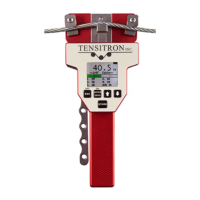ACX-1 Series Instrument www.tensitron.com pg. 5
3. SAFETY AND MAINTENANCE
WARNING: When using cordless, electronic instruments, always follow basic
safety precautions to reduce the risk of fire, electric shock and personal injury
READ AND SAVE ALL INSTRUCTIONS FOR FUTURE USE. Before use,
ensure all users read and understand this manual, as well as any labels
packaged with or attached to the instrument.
o Know your instrument. Read this manual carefully to learn your tension
meter’s applications and limitations, as well as the potential hazards
associated with this type of instrument.
o Avoid dangerous environments. Do not use your instrument in the presence of
explosive atmospheres (gaseous fumes, dust or flammable materials). Do not
submerge your instrument in liquids.
o Use the right tool or instrument. Do not use this instrument to do a job for
which it is not recommended.
o Check for damaged parts. Inspect instrument before use. Check for any
binding of moving parts, improper mountings, broken parts and any other
condition that may affect operation. Do not use a damaged instrument. Tag
damaged instrument “DO NOT USE” until repaired. For repair, send
instruments directly to Tensitron.
o Guard against electric shock.
o Maintain instrument carefully. Protect meter from exposure to water. Keep
instrument dry, clean and free from oil and grease. Do not lubricate. All roller
bearings are sealed.
o Do not use instrument if it has received a sharp blow, been dropped or
damaged in any way. Do not disassemble. Incorrect reassembly may result in
damage to the instrument and risk of electric shock and fire. If instrument is
damaged return it to Tensitron for repair.
o Unplug charger when not in use.
o WARNING: Only use battery pack assemblies provided by Tensitron with your
meter (P/N: BATTERY, ACX). Other types of batteries might explode, causing
personal injury and damage.
o To check this meter’s accuracy, see “Check Accuracy” on page 13. If meter is
out of calibration, return it to Tensitron for repair.
o Tensitron recommends calibration by the manufacturer at one-year intervals,
or sooner if the meter is worn, damaged, or reading incorrectly. However, it is
the responsibility of the user to establish a suitable calibration interval,
considering such factors as the user’s accuracy requirements, requirements
set by contract or regulation, and environmental factors such as frequency and
conditions of the meter’s use.

